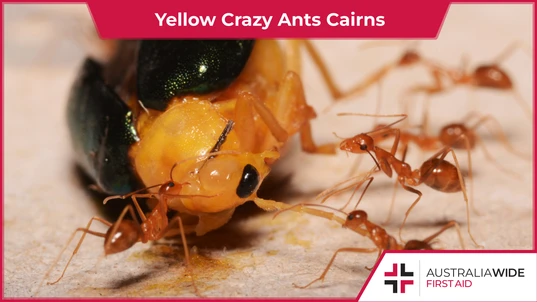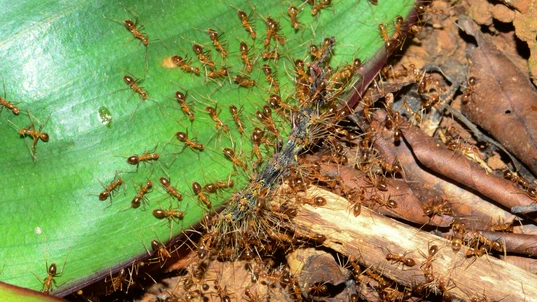The Yellow Crazy Ants of Cairns

Bites and Stings

Cairns is currently dealing with several infestations of Yellow crazy ants. Yellow crazy ants are one of the world's worst invasive species, as they swarm aggressively and spray formic acid as a defence and attack mechanism.
Cairns is currently suffering several infestations of Yellow crazy ants. These types of ants can infest residential areas, sugarcane fields and rainforest. Yellow crazy ants have made it into the world’s top 100 worst invasive species. So named because of their erratic, frantic movements when disturbed, Yellow crazy ants are pests to Australia and pose significant environmental and ecological harm. Yellow crazy ants don’t bite or sting, instead they spray formic acid from the tip of their abdomen. They use this acid to neutralise and consume their prey. Formic acid assaults can burn and irritate the eyes of animals and potentially humans. Continue reading for more information on what to do if you encounter an infestation of Yellow crazy ants. We also cover ant and other insect bites in our first aid courses: We offer these courses in Cairns and a host of other training locations across the country - head to our website to enrol in a training location near you.Appearance
Yellow crazy ants can be identified by their slender, golden-brown body and dark-brown (sometimes striped) abdomen. They are about half the size of a green ant and are considered fully grown at 4 mm. Yellow crazy ants tend to stick together in large numbers. With long skinny legs, Yellow crazy ants make distinctive “crazy” and erratic movements when uncovered or disturbed. They forage both day and night, and spray formic acid from their abdomen as a form of both defence and attack.Distribution and Habitat
Yellow crazy ants are not native to Australia and are considered pests. They are resilient and aggressive to every creature but their own. Yellow crazy ants work together harmoniously merging colonies to form super colonies, advancing sometimes by a metre a day. Believed to originate in parts of Asia, Yellow crazy ants can be found all over the tropical islands of the Indian and Pacific Oceans. Yellow crazy ants make new colonies with a queen and a few workers, and they are known to utilise human transport systems, such as cargo ships and green waste movements to spread their nests both locally and internationally. When settled, Yellow crazy ants can multiple, outnumber, and displace other species in the environment. Yellow crazy ants particularly enjoy settling into the rainforests and sugarcane fields surrounding the Cairns region. As omnivores, they find plenty to eat, but unfortunately tend to feed on insects and animals that are vital to the natural ecosystem as well as being unique to Cairns.Feeding
Yellow crazy ants are omnivores and will feed on seeds, fruits, worms, grubs and even small frogs, birds and lizards and young mammals. They work together to collectively bring down prey much larger than themselves by acting as a unit. Yellow crazy ants spray formic acid in defence and attack. Yellow crazy ants will swarm on animals that are too large for them to carry. The formic acid assault is targeted at soft, moist areas of animals, such as eyes. When the animal is neutralised, they will feast as a swarm in its place.
Yellow crazy ants represent an enormous threat to Australia's native flora and fauna. They band together to form super-colonies that can reduce lush rainforest into a trail of destruction.
Danger to Australia
Yellow crazy ants have a notorious reputation of turning lush rainforest into what researchers have described as a “stench of death”. Scientists have tracked and studied their destructive trail through Christmas Island, and they believe Yellow crazy ants are one reason why the Christmas Island pipistrelle and forest skink recently became extinct. In addition, researches observed a sharp decline of the unique red crab population on Christmas Island. Yellow crazy ants tend to overwhelm ecosystems and only protect insects and animals that attract their prey. For example, in the sugarcane fields, they’ll attack beetles that feed off honeydew and nectar producing insects (aphids and scales) in order to have a plentiful supply of the sugary substance from these insects. Unfortunately, residue left on the crops from these insects becomes mould and can destroy whole plantations as fast as the Yellow crazy ant colonies grow. Their formic acid spray can also burn and irritate the skin and eyes of animals, pets and potentially humans. Yellow crazy ants pose a great risk to the diversity of plant and animal life within Cairns and the greater north Queensland region.What to do if you encounter Yellow crazy ants?
If you spot a Yellow crazy ant colony, be sure to report the infestation to the Wet Tropics Management Authority, which is funded by the Queensland and Australian governments to protect and pass on the Wet Tropics World Heritage Area (to which Cairns belongs). Currently as part of a biosecurity plan to eradicate Yellow crazy ants, the Wet Tropics Management Authority will treat infestations for free. In order to assist in preventing the spread of these ants, be sure to follow any advice given from the authority. If you get their formic acid in your eyes, follow the first aid procedure listed in our article on poisoning.Final thoughts
Yellow crazy ants are a highly invasive species that have ongoing infestations in Cairns and surrounds. While Yellow crazy ants are relatively harmless to humans, they pose a significant risk to natural ecosystems. A colony can quickly become a super colony and overwhelm much of the native fauna and flora. Yellow crazy ants can also destroy sugarcane plantations and cash crops. Rather than a sting or a bite, Yellow crazy ants spray formic acid as a defence and attack mechanism, aiming particularly for the eyes of their prey. If you encounter a Yellow crazy ant infestation, make sure to report the incident to the Wet Tropics Management Authority, which is currently coordinating a Yellow crazy ant eradication program. If you are interested in learning more about how to treat and ant and other insect bites, enrol in one of our first aid courses: We offer these courses in Cairns and a host of other training locations across the country - head to our website to enrol in a training location near you today!
Originally published at
https://www.australiawidefirstaid.com.au/resources/yellow-crazy-ants-cairns
as part of the Australia Wide First Aid Articles Library









